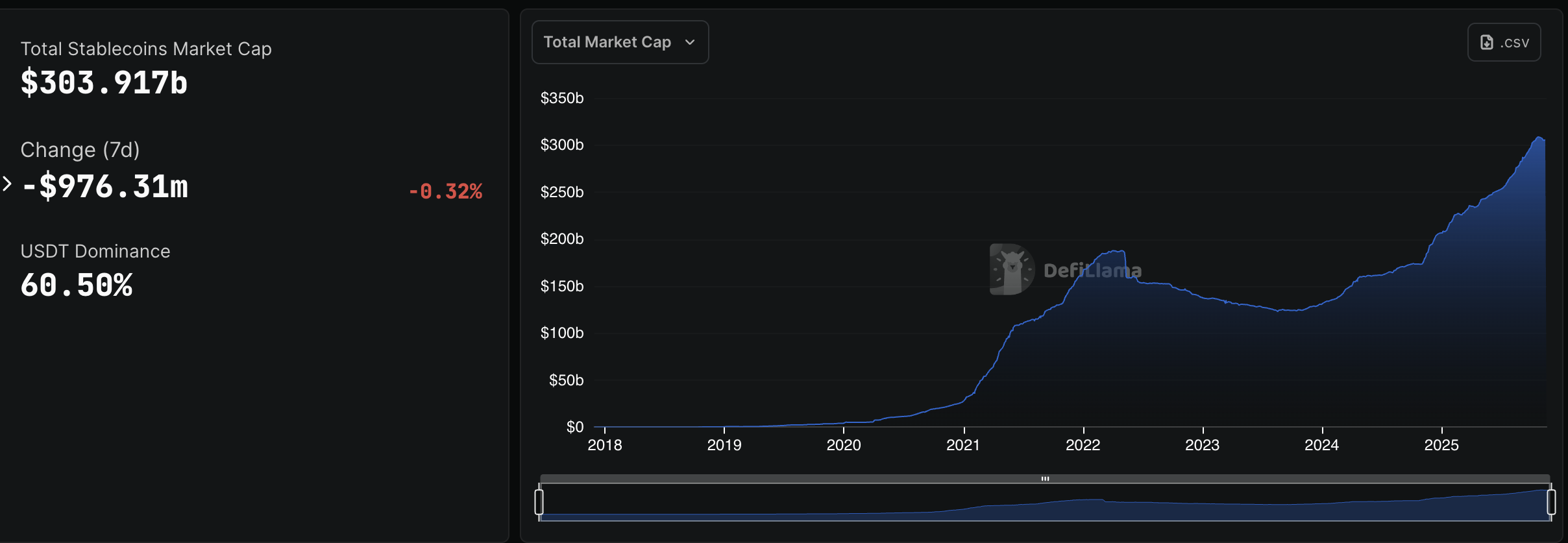European Central Bank Official Warns About the Impact of a Potential Stablecoin Sell-Off
A European Central Bank official warns that a large wave of stablecoin redemptions could pressure the ECB to adjust interest rates. With stablecoins surpassing a $300 billion market cap, officials fear rising financial-stability and monetary-sovereignty risks as adoption accelerates.
A mass redemption of stablecoins could force the European Central Bank (ECB) to adjust its monetary policy, a senior official warns.
Concerns are mounting about the risks posed by stablecoins, which have experienced strong growth, with their market cap exceeding $300 billion in 2025.
European Central Bank Raises Concerns Over Stablecoins
Olaf Sleijpen, President of De Nederlandsche Bank and a member of the European Central Bank’s Governing Council, has warned that the rapid expansion of stablecoins could have serious implications for Europe’s economy. Speaking about the accelerating growth of dollar-based stablecoins, he noted that if their adoption continues at the current pace, they could eventually reach a level where they become systemically important.
Furthermore, he emphasized that a wave of large-scale redemptions, essentially a run on stablecoins, could trigger market turbulence that extends far beyond the crypto sector.
“If stablecoins are not that stable, you could end up in a situation where the underlying assets need to be sold quickly,” Sleijpen told the Financial Times.
In such a scenario, he said that the ECB might be forced to reconsider its monetary policy stance. According to Sleijpen, the central bank could be pushed to adjust interest rates.
Nonetheless, it is unclear whether that would mean tightening or loosening policy. He emphasized that authorities would first rely on financial stability tools before turning to interest rate changes.
Hypothetically, if investors rush to redeem stablecoins, issuers might need to liquidate Treasury holdings quickly. Sharp sell-offs could drive up US government debt yields, leading to spillover effects in Europe’s bond markets.
When bond yields rise, financial conditions tighten, which can slow economic activity and affect inflation. The ECB might then have to adjust rates not for domestic reasons, but to counter instability from the crypto sector.
Previously, Jürgen Schaaf, an adviser in the ECB’s Market Infrastructure and Payments Division, issued a similar warning. He cautioned that if stablecoins become widely used in the euro area for payments, savings, or settlement, they could gradually weaken the ECB’s ability to steer monetary conditions.
Schaaf noted that this shift could mirror the dynamics seen in dollarised economies, where users gravitate toward the dollar for perceived safety or better returns.
According to Schaaf, a dominant role for dollar stablecoins would ultimately reinforce America’s financial and geopolitical position, enabling cheaper debt financing and expanding its global influence. Meanwhile, Europe would face relatively higher borrowing costs, reduced monetary policy flexibility, and greater strategic dependence.
“The associated risks are obvious – and we must not play them down. Non-domestic stablecoin’s challenges range from operational resilience, the safety and soundness of payment systems, consumer protection, financial stability, monetary sovereignty, data protection, to compliance with anti-money laundering and counter-terrorism financing regulations,” he added.
Stablecoin Adoption Accelerates Amid Market Expansion
The warnings from European officials come at a time when the stablecoin industry is experiencing rapid expansion amid major regulatory shifts. According to data from DefiLlama, the sector’s market capitalization has grown by nearly 48% this year alone. It now sits at over $300 billion.
 Stablecoin Market Performance. Source:
DefiLlama
Stablecoin Market Performance. Source:
DefiLlama
Tether continues to dominate the market with a market capitalization of approximately $183.8 billion. Its investment footprint has also grown significantly. The firm is the 17th-largest holder of US government debt worldwide — ahead of countries such as South Korea.
Additionally, stablecoin usage has accelerated. Monthly settlement volumes increased from $6 billion in February to $10.2 billion in August, a rise of approximately 70%.
Business-to-business activity has been particularly strong. It doubled to $6.4 billion per month and now represents almost two-thirds of all payment flows in the sector.
Forecasts suggest the expansion is far from over. Citigroup estimates that the global stablecoin market could swell to around $3.7 trillion by 2030. The US Treasury Department projects the market could reach $2 trillion as early as 2028.
If these projections materialize, stablecoins would become deeply integrated into global finance, amplifying both their economic relevance and the regulatory challenges surrounding them.
Read the article at BeInCryptoDisclaimer: The content of this article solely reflects the author's opinion and does not represent the platform in any capacity. This article is not intended to serve as a reference for making investment decisions.
You may also like
End of Privacy in Cryptocurrency as United States Adopts International Tax Standards
- The White House reviews a Treasury proposal to align U.S. crypto tax rules with the OECD's CARF framework, enabling IRS access to Americans' foreign crypto transactions. - CARF, adopted by 70+ jurisdictions including G7 nations, mandates automatic cross-border crypto transaction reporting to combat offshore tax evasion. - The framework would require foreign exchanges to report U.S. crypto holdings to the IRS, mirroring FATCA for traditional accounts while exempting DeFi transactions. - Domestic crypto ov

Bitcoin News Today: Institutional Exhaustion and Broader Economic Concerns Push Bitcoin Down to Lowest Point in 7 Months
- Bitcoin fell to a 7-month low below $95,000 amid profit-taking, institutional outflows, and macroeconomic uncertainty, mirroring a 5.8% drop in the CoinDesk 20 index. - Market fear intensified as the Fear & Greed Index hit 10 (lowest since Feb 2025), while MicroStrategy's rumored Bitcoin sales sparked panic despite CEO Saylor's denial. - Institutional fatigue and liquidity declines ($766M→$535.2M) raised correction risks, though Harvard's $443M IBIT investment signaled growing crypto acceptance amid vola
Bitcoin Updates Today: Bitcoin's $80,000 Support Falters as Regulatory Changes and Increased Selling Pressure Emerge
- Bitcoin drops to $89,900, with weak $89,600–$79,500 support raising fears of a breakdown below $90,300 amid heavy selling pressure. - Binance short positions dominate 6.4:1 ratio, while exchange reserves surge $1.43B, signaling panic exit preparations and reduced buyer leverage. - Japan reclassifies 105 cryptos as financial products, and Brazil considers stablecoin tax, adding regulatory uncertainty to crypto markets. - Institutional activity diverges: BitMine expands ETH holdings, while Mt. Gox’s $953M
Vitalik Buterin Backs ZKsync: Driving Ethereum's Layer 2 Transformation and Boosting Altcoin Growth
- Vitalik Buterin endorses ZKsync's Atlas upgrade, signaling a strategic shift in Ethereum's Layer 2 scaling. - The upgrade enables 15,000 TPS, near-zero fees, and boosts ZK token price by 50% post-announcement. - Institutional partnerships with Deutsche Bank and Citi highlight ZKsync's privacy-driven appeal in financial services . - ZK ecosystem grows with $3.5B TVL, driven by ZK rollups and hybrid TradFi-DeFi systems projected to reach $90B by 2031. - Regulatory risks and gas volatility persist, but ZK t
